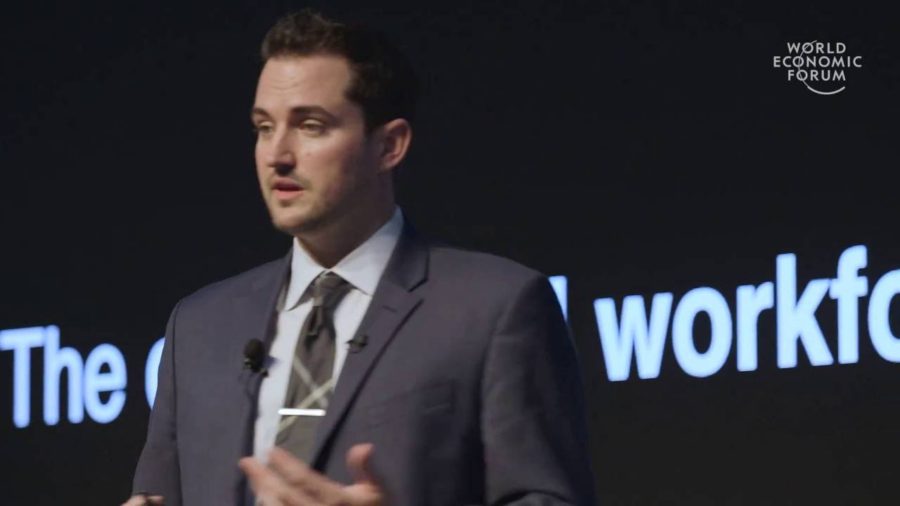This question is asked often, are robots going to take our jobs? This is what a factory predominantly looks like. Hundreds of thousands of factories all across the world. Whether this was 30 years ago or today, it’s actually still a fairly analogous example. You have machines and people working side by side.
What has happened, though, over the last handful of years is there is a dichotomy of behaviors happening. On one side, the Fourth Industrial Revolution is ushering in a significant increase in connected machines, connected products. And at the same time, the people who are standing next to these highly sophisticated machines are ultimately connected in their home lives. They carry a cell phone that’s managing their smart car, their smart home, their smart systems. But they have almost no interaction with the systems at work.
So think about this in our home lives. We go home, we are connected to everything. But when we come back to work, we’re going back to in many cases paper. In some cases the companies have digitized their work, but for the most part it’s a reference tool. You’re standing next to a machine; all of a sudden you don’t know what you need to do next; you pull out your phone; you look something up. You walk across the factory floor; you log into the one or two terminals that might be in the manufacturing space and you look it up.
And what we find is that knowledge in this case of work generally was accumulated before you got to the job. Or it’s training. So it’s your education and you’re trained, but it’s not necessarily highly transferable.
In the modern age that we’re entering into right now, we’ve got an increase in population. But we’re also assuming that there’s going to be an increase in consumption. One of the fears, of course, is that we’re going to be replaced by this insurgence of connected machines.
We’re also in the new normal. This is the first time in history—and will continue to be this way, I believe—that there are going to be and there are more connected devices than people. And it’s growing at a pace that is far outseating us. How does the machine world deal with that increase in population and the increase in connectivity? We have machine learning techniques. We have advanced AIs that start making sense of that data for the other systems, the other interconnections. But how do people engage with that?
What I’d like to do is show you an example, and this is from our own experiences, where the application of wearable technology, augmented and assisted reality, are opening up new opportunities for the human workforce to be engaged side by side with the autonomous workforce. And to do that I’m going to show you an example from Boeing.
Here Brian plays a promotional video for APX Labs’ project with Boeing, viewable at their site (captioned).
One example of many that we’re seeing right now. The average customer we work with, or other people in our industry work with, we see dozens and dozens of use cases. General Electric, for instance, has over a hundred use cases where wearable technology they believe can transform their business. And this is measured from an economic standpoint on an incredible scale. Forrester Research’s JP Gownder estimates that by 2020 up to fourteen million American workers will have smart glasses aiding in their manufacturing, field service, and logistics operations. And across the globe, roughly 50% developed world has what you’d consider an unconnected, deskless workforce, that their only disadvantage against robots in this case is access to information.
So we see in the manufacture world, it’s complex access to information. Could you get it? Could you see in real time? Could you remove that barrier to knowledge? In shipping and logistics, DHL is showing experiments where they’re getting between 15 and 20% improvement on the average pick and pack time. And again, the scale of this from a world economic standpoint, SAP alone runs seven hundred thousand warehouses around the world.
And one of the things I think I found most exciting about where this future portends, speaking with leaders at AGCO recently, and they were experimenting with wearable technology. And this part really kind of gave me an aha moment. They put smart glasses on users who had never built one of their tractors before, and raced them against the people who’d been doing it for years. And every time, they beat the pro, just by having real-time to access information. It could be as simple as what’s the torque value on the bolt I’m about to put on? Or where does this part go? But you’re able to remove confusion. You’re able to remove the uncertainties. And that cognitive load is actually the biggest challenge in our workforce.
So what we think, and this is I think the part that’s exciting if you’ve been worried about the rise of the robots. I think we have a very important part to play in a harmony of man with machine. It’s not about us having no future, it’s about removing a barrier. It’s about having access to information. And then it’s in the ability to remove frustration from the workforce. Enable them and empower them, and in turn unlock an amazing amount of latent value that exists in the human workforce today. So I believe that we’ll be competitive for many many years to come.
Further Reference
Annual Meeting of the New Champions 2016 at the World Economic Forum site
